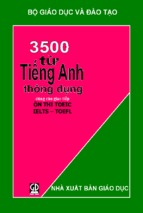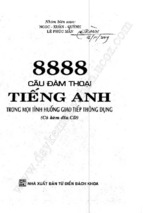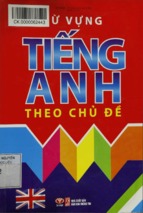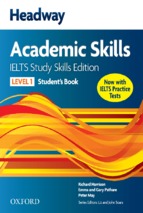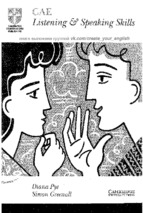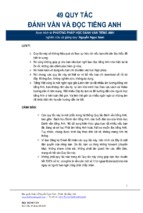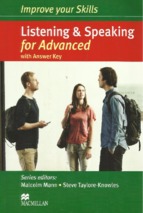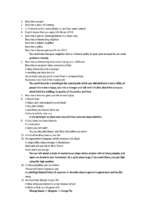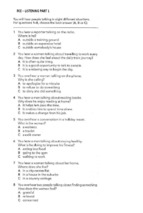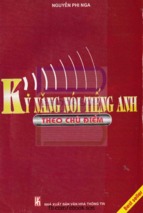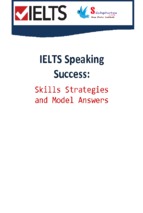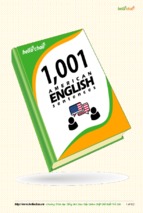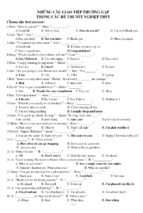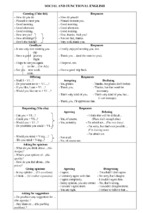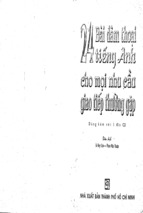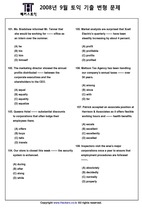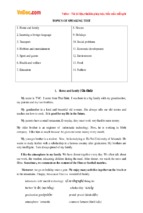VIETNAM NATIONAL UNIVERSITY, HANOI
UNIVERSITY OF LANGUAGES AND INTERNATIONAL STUDIES
FACULTY OF POST-GRADUATE STUDIES
TRẦN THỊ NGỌC MỸ
ESP MATERIALS DEVELOPMENT:
USING SITUATION-BASED VOCABULARY IN
COMPOSING AN ENGLISH HANDBOOK FOR
CUSTOMS OFFICERS IN NORTHWEST REGION
Xây dựng tài liệu Tiếng Anh chuyên ngành:
Sử dụng từ vựng dựa trên tình huống trong việc soạn thảo
Sổ tay Tiếng Anh cho cán bộ Hải quan vùng Tây Bắc
M.A. THESIS
Field: English Teaching Methodology (Type 1)
Field Code: 8140231.01
HANOI - 2018
0
VIETNAM NATIONAL UNIVERSITY, HANOI
UNIVERSITY OF LANGUAGES AND INTERNATIONAL STUDIES
FACULTY OF POST-GRADUATE STUDIES
TRẦN THỊ NGỌC MỸ
ESP MATERIALS DEVELOPMENT:
USING SITUATION-BASED VOCABULARY IN
COMPOSING AN ENGLISH HANDBOOK FOR
CUSTOMS OFFICERS IN NORTHWEST REGION
Xây dựng tài liệu Tiếng Anh chuyên ngành:
Sử dụng từ vựng dựa trên tình huống trong việc soạn thảo
Sổ tay Tiếng Anh cho cán bộ Hải quan vùng Tây Bắc
M.A. Thesis
Field: English Teaching Methodology (Type 1)
Field Code: 8140231.01
Supervisor: Dr. HUỲNH ANH TUẤN
HANOI - 2018
1
DECLARATION
I hereby certify that the thesis entitled “ESP materials development: using situationbased vocabulary in composing an English handbook for Customs officers in
Northwest region” is entirely my own research work and has not been taken from the
work of others save and to the extent that such work has been cited and acknowledged
within the text of my work.
Hanoi, 2018
Trần Thị Ngọc Mỹ
1
ACKNOWLEDGEMENTS
I am indebted to many whose warm support, cheerful encouragement, and genuine
guidance have been deeply appreciated.
First and foremost, I would like to express my honor to be a part of the project
KHCN-TB.26X/13-18 - Tay Bac Program, which is conducted by University of
Languages and International Studies, Vietnam National University.
I would like to send my enormous gratitude to Dr. Huynh Anh Tuan, my beloved
supervisor, who had patiently guided me throughout the thesis process, for his
insightful comments, invaluable guidance, thoughtful suggestions, and inspiration.
I am profoundly grateful to all those who participated, the wonderful Customs officers
in Vietnam and English teachers at University of Languages and International Studies
- Vietnam National University, who acted as informants in my research. I would also
like to thank Ms. Phan Thi Van Quyen, Ms. Le Thi Hong Duyen, and Ms. Vu Thi
Nga, who have given me such many precious support and thorough collaboration
during the study.
I would like to make special mention of my mother, Ms. Pham Thi Hang who has
given me an unending supply of all sorts of help and whose support has made it
possible for me to complete this study. Special thanks to my friends including Quynh
Trang, Thuy Linh, Thi Linh who have always been my full-time companions.
Thanks also go to family and friends who are not mentioned here for their support and
encouragement.
ii
ABSTRACT
In the context of international and regional integration and exchange, English
communication for work has become an essential requirement for cadres and civil
servants in various professions. It is in places where there is a lot of trade and
interaction with foreigners. Among them, the Northwest border customs is considered
one of the places where cadres and civil servants have many opportunities to interact
with foreigners coming from different countries. Recognizing the importance of the
English language as a tool of trade and exchange in the international environment, and
on the basis of practical needs of customs officers at the North West border gate, the
Northwest program team decided to compile a handbook of typical English words and
situations in Customs with the expectation of supporting the staff here in carrying out
daily tasks, thereby improving the efficiency of work and bringing about Economic
benefits for the North West area. This study is an attempt to investigate the principles,
strategies and procedures to compose an English handbook for Customs officers in
Vietnam. The research primarily focuses on the process of selecting situation-based
vocabulary for the officers to utilize in their real-life circumstances. In order to
develop common situations and select appropriate English vocabulary in Customs, the
team investigated the documents that are currently used in Nortwest border gates then
conducted observations, interviews at a customs office of the Northwest region, and
consulted experts in Linguistics and Customs to better modify the handbook. In
general, the vocabulary in the composed handbook has met the needs of Customs
officers in terms of both quantity and quality. The results gained from the finding and
data analysis has contributed to the ESP material development process. This study can
help ESP developer of other fields know how to start and what to do during materials
development procedures.
Key words: Northwest Program, ESP materials development, Customs, situationbased vocabulary
iii
TABLE OF CONTENTS
DECLARATION.................................................................................................. i
ACKNOWLEDGEMENTS ...............................................................................ii
ABSTRACT ....................................................................................................... iii
TABLE OF CONTENTS ..................................................................................iv
LIST OF ABBREVIATIONS ...........................................................................vi
LIST OF TABLES AND FIGURES................................................................vii
CHAPTER I: INTRODUCTION ...................................................................... 1
1.1.
1.2.
The rationale of the study............................................................................... 1
Aims and objectives of the study ................................................................... 4
1.3.
1.4.
Research methodology .................................................................................... 4
Scope of the study ............................................................................................ 5
1.5.
1.6.
Significance of the thesis ................................................................................. 5
Organization of the thesis ............................................................................... 5
CHAPTER II: LITERATURE REVIEW ........................................................ 7
2.1. ESP materials development ........................................................................... 7
2.1.1. Definition of ESP ........................................................................................... 7
2.1.2. Principles and procedures of developing ESP materials ............................ 8
2.1.2.1. Pre-development: Needs analysis ........................................................... 9
2.1.2.2. While-development: Developed content and Real content .................... 11
2.1.2.3. Post-development: On-going Evaluation .............................................. 12
2.1.3. ESP materials evaluation ............................................................................. 13
2.2. Situation-based vocabulary .......................................................................... 13
2.2.1. The importance of vocabulary in ESP teaching and learning ..................... 14
2.2.2. Situation-based vocabulary .......................................................................... 14
2.2.3. Strategies and principles of selecting situation-based vocabulary in
developing ESP materials ...................................................................................... 15
2.2.3.1. Choosing words: how many and which ones ........................................ 16
2.2.3.2. Learning tools for new vocabulary ....................................................... 17
2.2.3.3. Selection of vocabulary for developing ESP materials ......................... 18
2.3.
Related Studies on ESP material development for Customs Officers ..... 19
CHAPTER III: METHODOLOGY ................................................................ 24
3.1. Research questions ........................................................................................... 24
3.2. Research Design ............................................................................................... 24
3.3. Research Context ............................................................................................. 25
iv
3.4. Description of the informants ......................................................................... 27
3.5. Data collection instruments ............................................................................. 27
3.5.1. Document review ......................................................................................... 27
3.5.2. Observation .................................................................................................. 28
3.5.3. Interviews..................................................................................................... 29
3.5.4. Questionnaires ............................................................................................. 29
3.6. Data collection procedures .............................................................................. 31
3.7. Data analysis procedure .................................................................................. 33
3.8. Statement on how results were presented ...................................................... 34
CHAPTER IV: RESULTS ............................................................................... 35
4.1. Pre-development: The needs of Customs Officers in the Northwest region
of Vietnam ................................................................................................................ 35
4.2. While-development: The process of selecting situation-based vocabulary in
composing an English handbook ........................................................................... 37
4.2.1. Choosing words: how many and which ones .............................................. 37
4.2.2. Learning tools for new vocabulary .............................................................. 38
4.2.3. Selection of vocabulary for developing ESP materials ............................... 39
4.3. Post-development: The modifications of the handbook after reviewed...... 40
4.3.1. Evaluation of Language Experts .................................................................. 40
4.3.1.1. Strengths of the handbook ..................................................................... 40
4.3.1.2. Weaknesses and modification of the handbook ..................................... 41
4.3.2. Evaluation of Customs experts .................................................................... 44
4.3.2.1. Strengths of the handbook ..................................................................... 44
4.3.2.2. Weaknesses and modification of the handbook ..................................... 44
4.4. The English handbook for Customs officers in Northwest region .............. 47
4.5. Discussion .......................................................................................................... 48
CHAPTER V: CONCLUSION........................................................................ 50
5.1. Summary of the findings ................................................................................. 50
5.2. Contribution of the research and ESP development implications .............. 51
5.3. Limitations of the study and suggestions ....................................................... 51
REFERENCES .................................................................................................. 53
APPENDIXES ................................................................................................ - 1 Appendix 1: List of most common questions in Customs at Border gate ....... - 1 Appendix 2: Observation field note .................................................................. - 26 Appendix 3: Questionnaires for reviewers ...................................................... - 27 -
v
LIST OF ABBREVIATIONS
CEFR: Common European Framework of Reference for Languages
ESP: English for Specific Purposes
EFL: English as Foreign Language
ESL: English as Second Language
GE: General English
L2: The second language
ULIS: University of Language and International Studies
VNU: Vietnam National University
vi
LIST OF TABLES AND FIGURES
TABLES
Page
Table 1: Procedure of composing the English handbook for Customs
Officers
34
Table 2: Feedback from language experts for modification
41
Table 3: Feedback from Customs experts for modification
44
Page
FIGURES
Figure 1: Process for preparing new materials
11
Figure 2: Process for selecting vocabulary for the handbook
39
vii
CHAPTER I: INTRODUCTION
This initial chapter states the research problem and rationale of the study. Aims and
objectives of this research are also highlighted together with the three research
questions, and then the significance and scope of the study are introduced. Lastly, it
provides the organization of the study in order to guide readers into the right track of
the paper.
1.1. The rationale of the study
1.1.1. Northwest Program
Northwest Program or Tay Bac Program is a state-level key science and technology
program in the 2013 – 2018 period titled "Science and Technology for the Sustainable
Development of the Northwest Region" (called in short as the Northwest Program).
This program, targeted at Northern midland and mountainous provinces in Bắc Kạn
province, involved multiple stakeholders including the Bắc Kạn provincial People’s
Committee, the Ministry of Science and Technology, the Ministry of Education and
Training in coordination with VNU.
The Northern midland and mountainous region has great potential and tremendous
advantages for development, but also has to confront with difficulties and challenges
in development realities. Along with many target programs, the investment projects of
economic, social, cultural and educational development for the Northwest, on 28th
June 2013, implementing the directive of the Prime Minister, the Minister of Science
and Technology signed Decision No. 1746/QD-BKHCN on approval of the goals,
content and expected product of the Northwest Program. VNU was assigned to be in
charge of the program and former VNU President Phùng Xuân Nhạ is the Chairman of
the program.
The Northwest Program is the concretization of the strategic policy of the Vietnamese
Party and State: considering Science & Technology as the primary national policy to
promote to the highest degree the intellectual resources and create an impetus for the
1
development of knowledge-based economy in the Northwest region of Vietnam. By
solving issues in the development realities of the region and of each locality, the
program hopes to raise production capacity and competitiveness, promote the
advantages, resources and potential, to create an impetus for the raising of overall
growth level of the region and bring about the practical benefits to the community of
ethnic minority groups living in the Northwest provinces, contributing to ensuring the
national defense and security.
1.1.2. The role of English in Customs at the border gate
English has been acknowledged by most countries in the world as an international
language. Consequently, English has to be used in international communication both
orally and in written communication, for general as well as specific needs. English’s
role in the early development of modern technology has cemented its global
importance. In the context of rapid economic globalisation, Vietnam is now
conducting international business with countries across the world. As a result, English
is increasingly used as a lingua franca by Vietnamese people for foreign interactions
and communication.
The challenge of communicating at border gates is to create cohesion between
culturally distinct workforces. English, often considered a relatively neutral language,
acts as a bridge that connects people across countries and cultures, providing a
pathway for innovation. As a result, English has been chosen as an agent language
among countries. English has all the capabilities to facilitate the innovation economy
because it allows individuals and companies and organizations around the world to
communicate, and therefore collaborate toward a common vision or goal.
1.1.3. The necessity to conduct a study of composing an English handbook
for Customs Officers
In the context of international and regional integration and exchange, English
communication for work has become an essential requirement for cadres and civil
servants in various professions. It is in places where there is a lot of trade and
2
interaction with foreigners. Among them, the Northwest border customs is considered
one of the places where cadres and civil servants have many opportunities to interact
with foreigners coming from different countries. Recognizing the importance of the
English language as a tool of trade and exchange in the international environment, and
on the basis of practical needs of customs officers at the North West border gate, the
team learn and develop a handbook of typical English words and situations in customs
with the expectation of supporting the staff here in carrying out daily tasks, thereby
improving the efficiency of work and bringing about Economic benefits for the North
West area.
Working at the border gate means the major working environment of Customs
Officers is international. English becomes an important communication instrument
thanks to its globalization. Vietnam has a long border shared with Chinese, the use of
English as agent language can limit the superiority of Chinese and Chinese language
users in communication.
In addition, the number of travellers heading up into this part of the country is
increasing annually, due to the long-awaited opening of the border crossing into Laos
near Dien Bien Phu. As a result, foreign language is one of the basic requirements
imposed by employers in most of the industries, including the customs service. In this
regard, the Customs Officer administration required an English handbook aimed to
improve the knowledge of this language for their employees.
With the support of Vietnam Ministry of Education and Training and specialists from
University of Languages and International Studies, Vietnam National University, as a
part of Northwest program, the project “An English handbook for Customs Officers”
has been conducted. The target group consists of officers working Customs major in
general and Tay Bac Customs Officer Department in particular for communication
with tourists, enterprises and partners.
3
1.2. Aims and objectives of the study
The aim of the project is to develop an English for Specific Purposes (ESP) material
necessary for the efficient fulfilment of duties in customs, as well as facilitate crossborder communication.
To achieve this aim, the following objectives are established:
- To get an overview of the strategies and principles related to ESP materials
development to select vocabulary for Customs Officers in composing specialized
situations
- To conduct a needs analysis to identify the Customs officers’ working
situation, the officers’ need
- To propose an appropriate English handbook with appropriate vocabulary for
the target students based on the relevant theories and the need analysis.
- To investigate the opinions of experts and customs officers towards selected
vocabulary
The objectives can be summarized by three research questions below:
1. What are the process and the principles of choosing best-suited situation-based
vocabulary in composing an English handbook for Customs Officers in Northwest
region of Vietnam?
2. What is the need of Customs officers in Nortwest regions of Vietnam?
3. What are the opinions of the Linguistics experts and the Customs experts towards
the vocabulary used in the handbook?
1.3. Research methodology
To achieve the above aims, both qualitative and quantitative research methods were
used in this study, including secondary data collection, semi-structured interview, and
4
questionnaires. First, relevant literature, studies and available materials were reviewed
in order to get in-depth information. Second, the most common Vietnamese situations
in Customs field were collected from a Customs Department. A semi-structured
interview was conducted to find out the needs of targeted Customs officers. The first
draft of the handbook was produced based on the analysis of their needs. Both openended and close-ended questions were administered to Customs experts and officers to
find out their opinions towards the vocabulary and situation used in the handbook. The
results of the questionnaires led to the next modifications of the handbook.
1.4. Scope of the study
The focus of the study is on the situation-based vocabulary selected for the English
handbook for Customs officers; Customs experts and officers’ opinions towards the
vocabulary and the possible modifications for the handbook. There have been a
certain number of issues that worth digged into, such as the effectiveness of the
handbook or a suggested process for designing an ESP material for other majors.
However, they are not in the scope of this thesis because of the time limitation and
hoped to be investigated in another research.
1.5. Significance of the thesis
The researcher hopes that the findings of the study would help to generate a list of
useful vocabulary for Customs officers and figure out the difficulties ESP designers
may encounter while developing ESP materials. Practically speaking, the utilization of
the selected vocabulary is hoped to improve working effectiveness of Customs
officers in situations using English. The writer also expects strategies for composing
more practical English handbooks with integrated situation-based vocabulary which
can maximize the use of the material. The finding also benefits a large number of
customs officers who desires to use the handbook for self-study.
1.6. Organization of the thesis
The thesis is composed of five chapters in total. Following this introductory chapter
with some significant background issues concerning the current study is Chapter II in
5
which the theoretical framework for analyzing and interpreting the data collected for
the study, in coordination with related studies, is covered. In Chapter III, the research
site, research subjects, research instruments, the process of the field work as well as
the methods of data analysis are explained. Then in Chapter IV, with the guide of the
theoretical framework and research questions, the results of the study are displayed.
Finally, in Chapter V, the concluding chapter, the findings of the study drawn from
the research are summarized for related future work will also be presented.
6
CHAPTER II: LITERATURE REVIEW
The aim of this research is to develop situation-based vocabulary for Customs officers
in the Northwest region of Vietnam, the theoretical framework was used is completely
based on ESP materials development. This chapter is concerned with the review of a
theoretical base to develop a framework in which the study operates. As a way of
start, I will first explore the two notions, ESP definition, principles in developing ESP
and material evaluation. Then, I will present an overview of vocabulary, situationbased vocabulary and process of selecting situation-based vocabulary. Last but not
least, previous studies on ESP development are mentioned.
2.1.
ESP materials development
This section discusses the issues related to the ESP materials development. All the
ESP developers should take the following terms under consideration:
-
What is ESP?
-
What are the issues to consider in developing the ESP materials?
-
What are the techniques used for material evaluation?
The reviewed term will set light on the way we conduct the research in composing a
handbook for Customs Officers in Northwest regions of Vietnam. ESP can be defined
as teaching and learning English as a second or foreign language for the purpose of
using it in a particular domain.
2.1.1. Definition of ESP
ESP has become a separated part of Teaching English as a Foreign Language (TEFL)
since 1960s owing the fact that English has become the contemporary lingua franca.
The growing demand for English as a medium of communication and the introduction
of governmental mass educational programs contributed to the rapid expansion of
ESP.
7
There have been a number of ESP definitions, “situations where the student has some
specific reasons to learn a language” in the opinion of Harmer (1983, p.45) or “an
approach to language teaching in which all decisions as to content and methods are
based on the learner’s reason for learning” by Hutchinson et al (1987, p.89). The same
idea is stated by Strevens in The Learner and the Teacher of ESP that “ESP is
particular case of general category of special-purpose language training.” (1988,
p.132)
Ten years later, Dudley-Evans and St John (1998, p.1) state that “the main concerns of
ESP have always been, and remain, with needs analysis, text analysis, and preparing
learners to communicate effectively in the tasks prescribed by their study or work
situation”. They classify ESP into English for Academic Purposes (EAP) and English
for Occupational Purposes (EOP) and claim these distinctions are very important as
they will affect the degree of specificity that is appropriate to the course.
As specified by Kim (2008, p.76), in more recent times, the following characteristics
of EOP have emerged: i) There is a clear purpose (e.g., business skills for
presentations in English, business letter writing, etc.); ii) It addresses needs in
proficiency, as revealed by a needs analysis, of workplace needs; iii) It tantamounts to
responding to, and satisfying, educational needs; iv) The relevant vocabulary and
expressions related to their workplace; and, v) It is more suited to immediate needs,
and serves more practical purposes than GE in the workplace. Those are the features
that are adopted in this research as it draws an overview about EOP/ESP materials that
are being developed.
2.1.2. Principles and procedures of developing ESP materials
Given the characteristics of developed materials, design processes are always divided
into steps and phases in order to make sure that checks and tests are carried out at the
appropriate time to avoid any lengthy and costly time consuming modifications at the
end. ESP development involves the following three stages: pre-development, whiledevelopment
and
post-development. Analyzing learners’ specific needs and
evaluating the relevant existing materials is the first and foremost steps. Then several
8
important factors need to be considered in the development process. After finishing,
developers also need to get a full understanding of the feedback from the
materials users and experts.
2.1.2.1. Pre-development: Needs analysis
According to Cunningsworth (2002), what makes ESP different from GE is that
ESP is goal-oriented and based on the awareness of learners‘ needs. Thus,
identifying what learners need has a significant influence on the development of
appropriate ESP materials.
Since the begining stages of ESP (the 1960s and early 1970), needs analysis have
consisted in assessing the communicative needs of the learners and the techniques of
achieving specific teaching objectives. Nowadays, the tasks of needs analysis is much
more complex. According to Angouri (2010), ESP seeks a congruent approach to
provide learners with both content of the specialist and the linguistic knowledge to
develope communicative skills necessary for work-related communication. ESP has
been defined as “viewing learners in terms of their work or study roles, not personal
needs or general interest” (Basturkmen, 2010, p. 3). The value of ESP and other
content-related language teaching is that they are context specific and marry specific
workplace needs with language learning. This is important because “the linguistic
proficiency in everyday settings is incommensurably different from the linguistic
proficiency in classroom settings, even in classrooms that purport to be
communicatively oriented” (van Lier, 2002, p. 145). ESP prepares learners to be able
to use English in academic, professional or workplace settings (Mohammadi &
Mouasvi, 2013).
For Robinson (1991), needs analysis may be a combination of both the target
situation analysis (TSA) and present situation analysis (PSA). TSA aims at students‘
needs at the end of the course while PSA focuses on students‘ strengths and
weaknesses at the start of the course. Two divisions of need, target needs and
learning needs, are also identified by Hutchinson & Waters (1987). Target
needs are analyzed in terms of (i) what the learner has to know in order to
9
function effectively in the target situation, (ii) the gap between learners‘ existing
proficiency and target proficiency, and (iii) learners‘ view as to what their needs are.
However, consideration of target situation needs alone is not enough since the
target situation is not reliable in terms of what is needed or useful in the ESP
learning context.
Only after analyzing the students’ needs and determining the objectives of the
language course, we can select a material that meets the needs of the students.
Therfore, needs analysis is the foundation on which we can develop materials that can
lead to increasing the language users’ motivation and success. Because ESP materials
are based on needs analysis, the objectives are more obvious than would be in the case
of general ESL ones and it can be assumed that students will be more highly
motivated in learning about topics and texts which are related to their study or work
areas. So, needs analysis and material evaluation are tighted together so that needs
analysis determine the needs for a defined group of people and evaluation helps the
ESP designers determine to what extent those materials meet the learners’ needs|.
(Stern, 1992, p.82).
In 1987, Hutchinson and Waters created a framework concerning the relevant
information that a course designer needs to gather from an analysis of target needs and
learning needs. Hutchinson and Waters (1987) believed that asking question is a
pathway to receive the assessment of target situation needs and learning needs. What
the learners have to do in the target situation (language use) are target situation needs,
while language learning is how people study the language. Below is the list of the
target situation analysis framework:
-
Why is the language needed?
-
How will the language be used?
-
What will the content areas be?
-
Who will the learner use the language with?
10
-
Where will the language be used?
-
When will the language be used?
2.1.2.2. While-development: Developed content and Real content
Dudley-Evan & St John (2009) highlight that matching between developed content
and real content should be taken into consideration in the process of preparing new
materials. Developed content can be defined as the subject matter used to teach the
specific language whereas real content refers to the language or skill content of a
language practice.
The former is usually found in ESP textbook or documents
whereas the latter is the language tool used in real-life situations. It would be
considered to be a qualified material if those two are as similar as possible so that the
language learners can apply what they have learned into their daily use and make the
language knowledge their own. Due to that relationship, Dudley-Evans & St
John then propose two possibilities in preparing new materials with the two
types of content as shown in the graph below:
Process for Preparing New Materials
Starting point A
Starting point B
have some developed content
need material for specific objective
determine its real content
search for suitable developed content
match real and developed
content to course framework
Figure 1: Process for preparing new materials (Dudley-Evans & St John, 2009, p. 177)
The first possible starting point is to have good developed content. The next
stage involves analyzing it to decide on the real content and think about how
the real content can fit in. The second possibility starts from where there is a need for
some materials to reach the specific course objectives but there is no suitable one at
first, so searching for the suitable developed content is necessary.
11
- Xem thêm -



